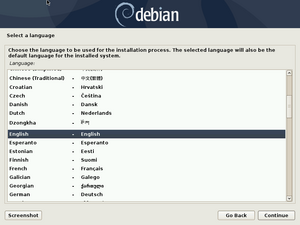Software:Debian-Installer
This book may need to be updated to reflect current knowledge. |
 The language select screen of the Debian Installer | |
| Original author(s) | Debian Project |
|---|---|
| Developer(s) | Debian Install System Team |
| Initial release | June 6, 2005 |
| Stable release | 12 (Bookworm)
/ June 10, 2023[1] |
| Written in | C |
| Operating system | Microcosm of Debian, made of udebs (loading from Windows is supported via win32-loader) |
| Available in | 87 languages |
| Type | System installer |
| License | GPL |
| Website | www |
Debian-Installer is a system installer designed for the Debian Linux distribution. It originally appeared in the Debian release 3.1 (Sarge),[2] released on June 6, 2005,[3] although the first release of a Linux distribution that used it was Skolelinux (Debian-Edu) 1.0, released in June 2004.[4]
It is also one of two official installers available for Ubuntu, the other being called Ubiquity (itself based on parts of debian-installer) which was introduced in Ubuntu 6.06 (Dapper Drake).
It makes use of cdebconf (a re-implementation of debconf in C) to perform configuration at install time.
Originally, it was only supported under text-mode and ncurses. A graphical front-end (using GTK-DirectFB) was first introduced in Debian 4.0 (Etch). Since Debian 6.0 (Squeeze), it is used over Xorg instead of DirectFB.
debootstrap
debootstrap is software which allows installation of a Debian base system into a subdirectory of another, already installed operating system.[5] It needs access to a Debian repository and doesn't require an installation CD.[5] It can also be installed and run from another operating system or to create a "cross-debootstrapping", a rootfs for a machine of a different architecture,[5] for instance, OpenRISC[clarification needed].[6] There is also a largely equivalent version written in C – cdebootstrap, which is used in debian-installer.[5]
debootstrap can be used to install Debian in a system without using an installation disk but can also be used to run a different Debian flavor in a chroot environment.[7] This way it is possible to create a full (minimal) Debian installation which can be used for testing purposes, or for building packages in a "clean" environment (e.g., as pbuilder does).[7]
Features
- Set language
- Select location
- Configure keyboard
- Configure network
- Setup users and passwords
- Configure clock
- Partition disk
- Create partition
- Format device
- LVM/Cryptsetup
- Install system base
- Configure package manager
- Configure mirrorlist
- Configure bootloader
See also
References
- ↑ "Debian "bookworm" Release Information". Debian. https://www.debian.org/releases/bookworm/.
- ↑ "Debian GNU/Linux 3.1 released". Debian. 2005-06-06. https://www.debian.org/News/2005/20050606.
- ↑ "Debian "sarge" Release Information". Debian. https://www.debian.org/releases/sarge/.
- ↑ "First distribution ships with Debian-Installer". Debian. 2004-06-21. https://www.debian.org/devel/debian-installer/News/2004/20040621.
- ↑ 5.0 5.1 5.2 5.3 "Debootstrap". Debian wiki. https://wiki.debian.org/Debootstrap.
- ↑ Svensson, Christian. "[Openrisc Introducing: Debian for OpenRISC"]. Openrisc mailing list. OpenCores.org, equivalent to ORSoC AB. http://lists.opencores.org/pipermail/openrisc/2014-January/001565.html.
- ↑ 7.0 7.1 "debootstrap". Debian man pages. https://manpages.debian.org/buster/debootstrap/debootstrap.8.en.html.
External links
 |

